But some say latest economic data not as bad as it seems; market mispricing could be buying opportunity
The stock market was buffeted by another round of bad news this week, underscoring the overall weakness of the U.S. economy and sending equity investors running for cover.
As market watchers try to analyze the economic data and navigate the pitfalls, financial advisers are bracing for the worst.
“As of today, I'm holding my breath and hoping the markets keep their stuff together,” Clinton Struthers, owner of Struthers Financial Services, said Thursday.
“I think there are a lot of people out there looking for a reason to say the economy is stalling and that the end is coming,” said Mr. Struthers, whose firm has $100 million under advisement.
“A good correction in the markets would be just the thing to show that to be the case,” he said. “There's nothing like a good conspiracy to get people worried.”
At this point, the conspiracy looks more like a riddle involving multiple scenarios that could take more than a month to decipher.
Friday's weaker-than-expected May employment report, which showed the fewest number of jobs created in eight months, was the most recent blow to a market that already had been beaten down by negative reports on auto sales and manufacturing production. The S&P 500 index shed more than thirty points this week, falling to just a bit above 1,300.
“The stock market is reacting to repeated evidence that the U.S. economy has hit a soft patch, and done so at the same time that other parts of the world are also slowing,” said Mohamed El-Erian, chief executive and co-chief investment office at Pacific Investment Management Co. LLC.
A big question, of course, is how much the economic slowdown is fallout from the March 11 earthquake in Japan, which caused major disruptions in global automobile production.
A report this week showed sales by U.S. automakers were flat from April to May, while sales at European carmakers were up more than 4% and sales by Asian automakers were down more than 20%.
Current estimates for the quarter ending June 30 is that total auto production will be down 18% from the first quarter of the year.
The closely watched monthly survey from the Institute for Supply Management, which measuring expansion in the manufacturing sector, this week reported a record drop of 6.9 percentage points in the index, to 53.5%.
Even though the ISM index's current level represents the 22nd month of expansion in the manufacturing sector, the sudden downward spike was enough to rattle the markets.
“The markets are being surprised on the downside by all the economic data, but I still don't think things are as bad as the data would indicate,” said Paul Zemsky, chief investment officer at ING Investment Management.
“However, [the data] caused people to question the outlook for the economy. That leads to questions about earnings, and then you have to ask questions about the price of stocks,” Mr. Zemsky said.
Because Japan's manufacturing sector is just starting to come back on line, there is hope that by the middle of July the ripple effects of increased global economic activity will lead to some improved economic data.
“Right now, the market is looking for indicators as to whether this is mostly Japan-related and the slowdown is temporary, or a permanent thing,” said Ray Humphrey, senior portfolio manager at Hartford Investment Management.
“If you're bullish on the economy, you say, ‘This is the lagged effect of the slowdown in the Japanese economy,'” he added. “And if you're bearish, you say, ‘It's a combination of Japan and a weaker global demand,' which could mean that Japan would be coming back on line into a weaker economy.”
The weaker demand, according to Mr. Humphrey, is a direct result of the U.S. government's $600 billion quantitative-easing program, which made U.S. exports more attractive by devaluing the dollar.
The weaker dollar wrought havoc on some emerging economies that peg their currencies to the dollar, and has resulted in energy and food inflation.
“I think it would be very naïve to think the Fed didn't know this was going to happen, but they had no other lever to pull,” Mr. Humphrey said. “And now, they can't pull that [quantitative-easing] lever again because inflation is already too high. So if it turns out the economy is truly weakening anew, there is nothing that Washington or the central bankers can do to save it.”
Of course, there also is the glass-half-full perspective that focuses on solid productivity and consumer spending levels, $2.5 trillion in cash on corporate balance sheets, 18% first-quarter-earnings growth by the S&P, and eight consecutive quarters of the benchmark beating Wall Street earnings estimates.
“You can't trust some of these interim reports, because they're not really indicative of how well the economy is doing,” said Donald Schreiber, chief executive of WBI Investments, which has $775 million under advisement.
“We're going to continue to have challenges, and right now, there's a fear-based mentality where everybody is waiting for the next shoe to drop,” he said. “I think this creates a buying opportunity where we can pick up some great companies and wait for investors to price the market accordingly.”







